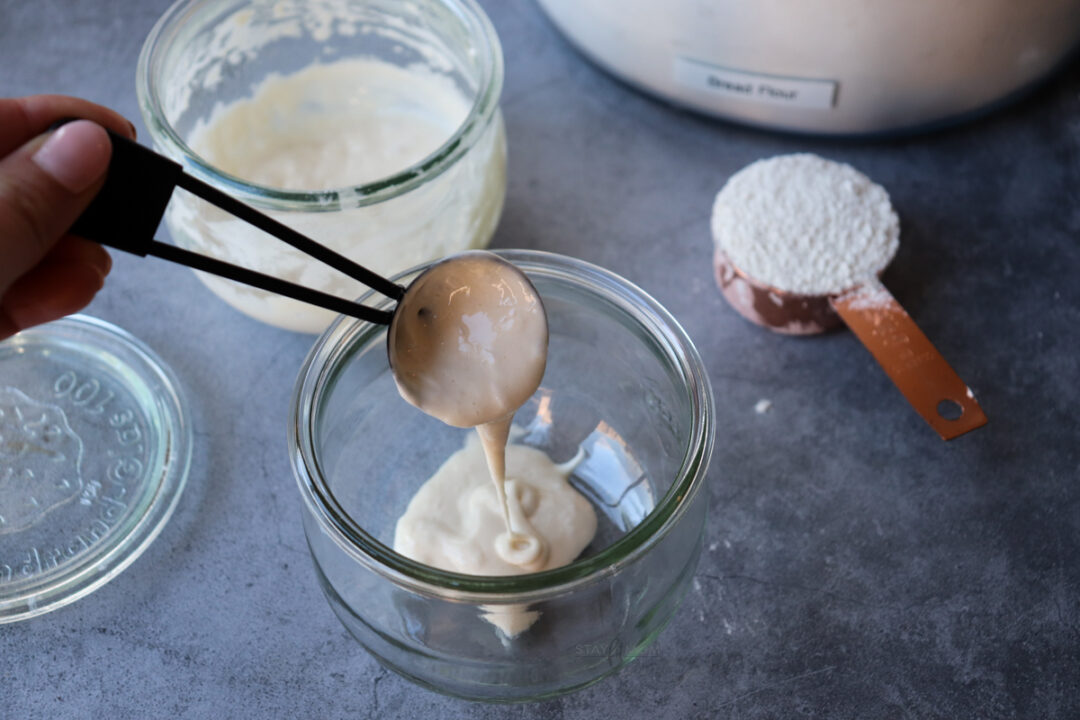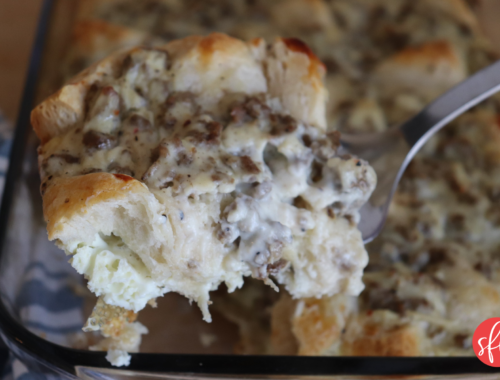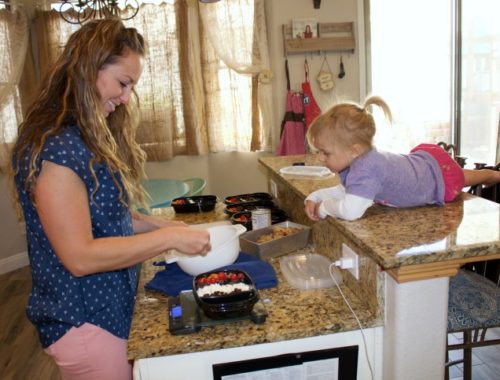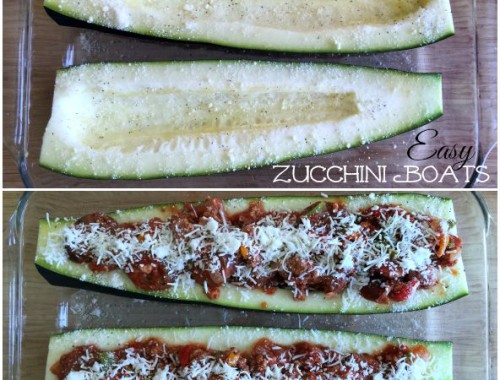Let’s learn how to feed and maintain a sourdough starter! I’m excited to continue to share my love of sourdough with you all. I’m going to try and simplify the whole process as much as possible. I truly find maintaining a sourdough starter and baking bread to be so therapeutic. Not to mention there is something so dang cool about making bread from scratch just like our ancestors did with just flour, water, and salt.

This post contains affiliate links. If you purchase something from these links, we could earn a small commission. This would be at no additional cost to you.
What is Sourdough Starter?
Sourdough starter is a natural yeast used to make bread rise. Your starter is a living culture of yeast and bacteria, and therefore needs to be cared for and fed regularly. Feeding your starter is very quick and easy. Over time you will learn to recognize the look and smell of the starter. Soon enough you’ll know exactly when it’s time to feed or use your stater just by looking at it.
Where to Get a Sourdough Starter
Making your own starter from scratch can be very time consuming and might burn you out before you even have a chance to make a loaf of bread. If you’re brand new to sourdough, I highly suggest getting some from a friend, asking in a local neighborhood Facebook group if someone can share some with you (or sell you some), or purchasing one online. Here are a couple options for purchasing sourdough starter online:
- King Arthur Fresh Sourdough Starter
- San Francisco Sourdough Style Starter Culture
- Ballerina Farm Dehydrated Sourdough Starter

Supplies Needed to Feed & Maintain Your Sourdough Starter
Wide Mouth Jar with Lid – I like having 2 starter jars so I can periodically switch to a clean, new jar. I love the 744 1/2 L Tulip Jars from Weck best, but they’re a little tricky to find. I bought mine in store at Cost Plus World Market, but you can find them online occasionally. I can’t seem to find any sold individually, but Amazon does sell this Weck combo pack I think would work great. It comes with a 744 (pictured above), and 745 (you’ll want for your levean) and a 762 which I think would work just fine for starter.
Measuring Spoons and Cups – Most of us have these laying around but if not, I linked a pretty copper set for ya. You’ll need a 1 tablespoon measuring spoon and 1/4 cup measuring cup to feed your starter.
Bread Flour – I like to use King Arthur bread flour to feed my starter. All purpose will get the job done, but bread flour works best for a good, strong starter. I use King Arthur’s unbleached bread flour from my local grocery stores. They sell an organic option online if you prefer organic.

When to Feed Your Sour Dough Starter
Your sourdough starter is full of naturally occurring yeasts and bacteria, and must be fed to keep it alive and thriving. You must feed it daily if left at room temperature on your counter. You can however place it in the refrigerator for 1-2 weeks at a time between feedings if you’re not using it. Because my starter is well established, I’ve gone on vacations before and left it in my fridge for well over a month and was still able to feed and revive it. Sourdough is very forgiving, especially if you have a good strong starter.
- DAILY when sitting on the counter at room temperature.
- WEEKLY (or bi-weekly if your starter is well established) when in your refrigerator.
How to Feed Your Sourdough Starter
If you purchased a starter online follow the directions that come along with it until your starter is well established and active(very bubbly). If you purchased or have been given some fresh starter, follow the instructions below.
- To a new clean jar add 1 tablespoon of the starter. (Or discard all but 1 tablespoon of your starter in the current jar)
- Add 1/4 cup of bread flour.
- Add 3 tablespoons of room temperature water.
- Stir well. It should be really thick.
- Cover with lid and place on the counter for up to 24 hours before feeding again. If you don’t have plans to use your starter in the next few days, let it sit on the counter for at least an hour(to start fermenting some) and then place it in the fridge with the lid secured(fasten with the Weck jar clips or screw on your mason jar lid) for up to 2 weeks.
I like this feeding method because it keeps my starter small and I’m not wasting flour. I also love that I don’t have a huge jar taking up space in my refrigerator(where my starter spends most of it’s life). When it’s time to actually prepare to make bread we will make a larger starter(aka our levean).
Sourdough Discard
Sourdough discard is the portion of your starter that is left behind in the old jar, or what is removed from your starter jar before feeding. Some people save their discard to use in other recipes. You can keep a large jar in your fridge specifically for all your discard, and add to it each time you feed your starter. Though this discard isn’t active starter, it’s often used to make things like bread, cookies, or pancakes. It’s still rich in probiotics and beneficial to our gut microbiome.
Step By Step With Images
- To a new clean jar add 1 tablespoon of the starter. (Or discard all but 1 tablespoon of your starter in the current jar)

2. Add 1/4 cup of bread flour.

3. Add 3 tablespoons of room temperature water (I just filled up my measuring cup 3/4 of the way – this is very forgiving, no need for it to be perfect)

4. Stir well. It should be really thick. See below.

5. Cover with lid and place on the counter for up to 24 hours before feeding again. If you don’t have plans to use your starter in the next few days, let it sit on the counter for at least an hour(to start fermenting some) and then place it in the fridge with the lid secured(fasten with the Weck jar clips or screw on your mason jar lid) for up to 2 weeks.

I’m excited to share my sourdough recipe with you next! I’ll take you step by step through how I make my delicious bread so you can make some too! I’ve been sharing my bread on IG for several years now and you can always find some of my recent sour dough content here: SOUR DOUGH HIGHLIGHTS
Let me know if you have any questions, I’m happy to help!





5 Comments
Thanks so much for sharing. I am just getting started with sourdough and this was extremely helpful. However I did not see the actual recipe. Am I missing something?
Thanks!!!
Hi Ellie! The recipe for sourdough bread is coming April 4th! I wanted to share the starter feeding method first so everyone can prepare their starters. Stay tuned!
Hi there, I’m curious about why you choose to use measuring spoons & cups as opposed to a kitchen scale. Any particular reason?
Hi! When starting a new starter from scratch you’ll need to be precise and use a kitchen scale. Once you have a mature starter it is no longer necessary to measure daily just to feed it. I do get the scale out when it’s time to make my levain for bread.
Hi! Thank you so much for sharing! I’m fairly new to sourdough but am so excited to switch over to your recipe so I have less wasted discard (I just don’t do much with it).
When feeding my starter that’s been in the fridge, so you take it out to warm up on the counter first or just feed cold?
Thanks much!